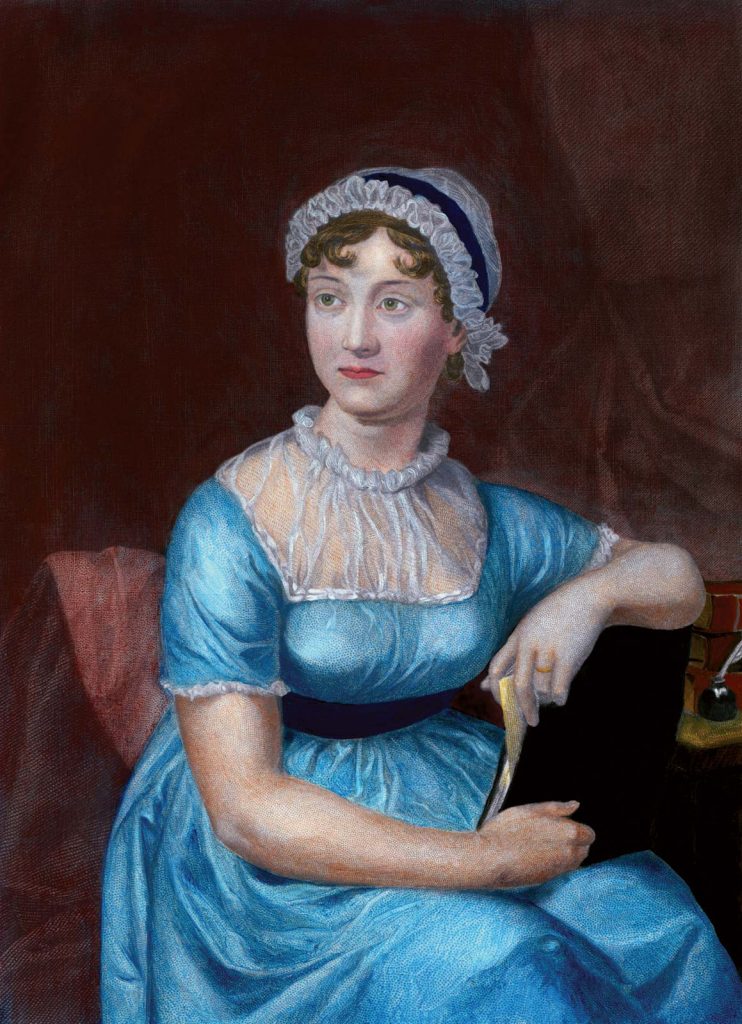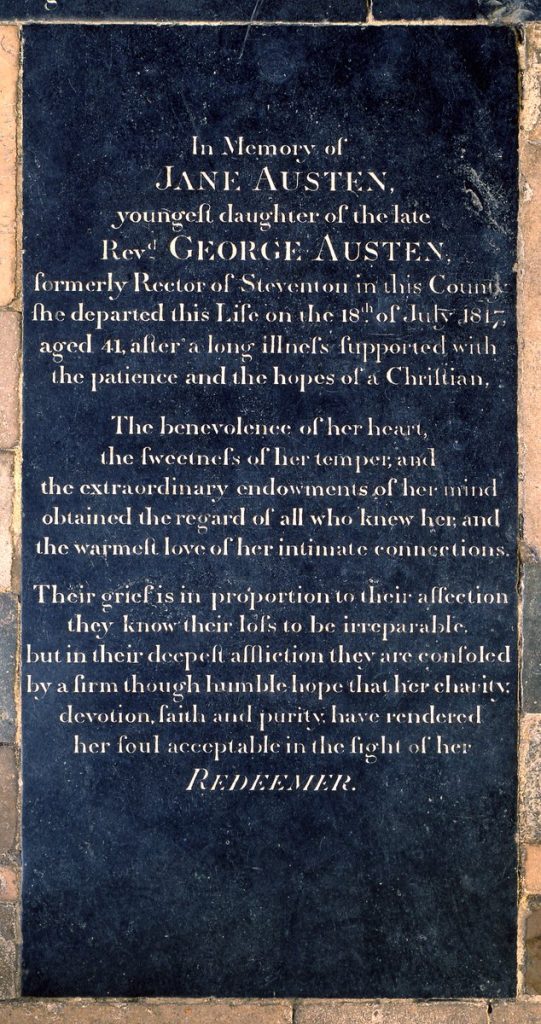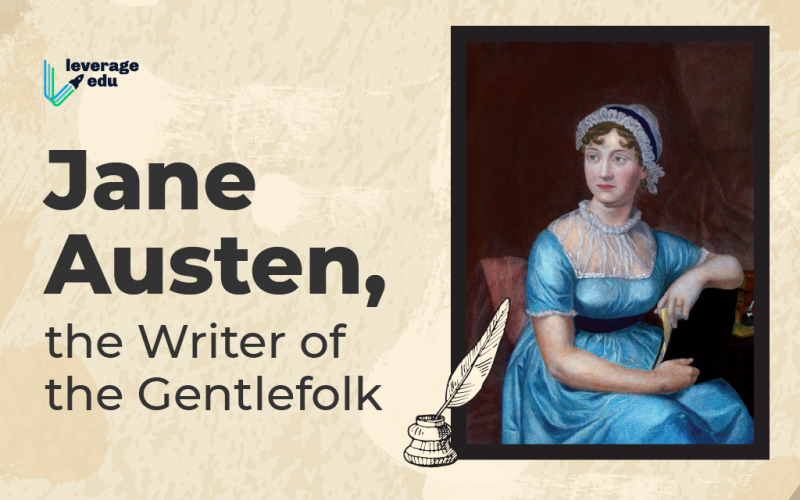A woman who is still known because of the revolution that she brought into the world of literature through her masterpieces and words was none other than the famous author and writer of the modern era of literature, Jane Austen. From a very young age, she realised the bitter truth that humans are forgotten when they die, but their ideology and the literature that they have imprinted or written co-exists, making their presence still after death. This is a small tribute to the evergreen and revolutionary author of that era when women’s opinions were not even taken seriously or ever heard.
Must Read: Jhumpa Lahiri, The Torchbearer of Diasporic Literature
“There is no charm equal to the tenderness of the heart.”
Early Life and Family Background
On December 16, 1775, Jane Austen was born in Steventon, Hampshire, to a close-knit family. With six brothers and one sister, she was the seventh of eight children. Her father was an orphan who went to school and was ordained by the Church of England with a wealthy uncle’s aid. As a result, he rose in his social status and standings enough to marry Cassandra, her mother. Her father was appointed rector of Steventon, a village in north Hampshire about 60 miles southwest of London, in 1765.
“A person may be proud without being vain. Pride relates more to our opinion of ourselves, vanity to what we would have others think of us.”

Let us now learn a little about Jane Austen’s siblings. Two of Austen’s older brothers, James and Henry, were both ordained and spent most of their lives in the Church of England, much like their father. Jane Austen was undoubtedly the closest to Henry of all her brothers. Her brother was not only her agent but also her biographer after she died. George, the second oldest son, was born mentally ill and spent much of his life in a psychiatric hospital. Edward, Jane Austen’s third sibling, was adopted by her father’s wealthy cousin, Thomas Knight, and ultimately inherited the Knight estate in Chawton, where she had written most of her novels in later parts of life.
Jane Austen’s only sister, Cassandra, was born in 1773, and throughout their lives, Austen and Cassandra were more like close mates and companions than sisters. The biographers were able to piece Jane Austen’s life together just because and with the help of the letters that she wrote to Cassandra in later years of her life. Francis and Charles were the two youngest Austen brothers who served in the Navy as highly decorated admirals.
“Nobody minds having what is too good for them.”
Jane Austen’s Education
Mrs Ann Cawley sent Jane Austen and her sister Cassandra to Oxford to be educated in 1783, and she took them with her to Southampton when she moved there later that year. However, later in the autumn, both girls were sent home after catching typhus (a bacterial infection) and almost dying from typhus fever.
Jane Austen received her education from her home until 1785 when she went to boarding school in Reading with her sister at the Reading Abbey Girls’ School. Jane Austen had the wonderful opportunity to learn French, spellings, needlework, dance, music, literature, history, and possibly drama at the Reading Abbey Girls’ School. Because the school fees for the two girls were too high for the Austen family, especially Jane Austen’s parents, the sisters returned home before December 1786. Jane Austen never left the confines of her immediate family world after 1786. Her remaining schooling and learning were then completed with the assistance of her brothers and father, who instructed her in reading various literature and manuscripts.
“Friendship is certainly the finest balm for the pangs of disappointed love.”

Early Work and Juvenilia
Jane Austen probably started writing from a very young age in life. She tried her hand at dramatic writing when she was 12 years old. During her teens, she also wrote three short plays. She began writing and indulging in poems and stories for her own and her family’s enjoyment at 11 and possibly earlier.
From the beginning, her use of biting irony, as well as her realism, satire, and social commentary, had won her praise from critics, academics, and general audiences. Jane Austen has compiled copies of almost 29 early works and stories into three bound notebooks, which are now being known as the Juvenilia. It contains all the literature and approximately 90,000 words that she wrote between 1787 and 1793. She named these books “Volume the First”, “Volume the Second”, and “Volume the Third”.
| Juvenilia: Volume the First (1787–1793) | Juvenilia: Volume the Second (1787–1793) | Juvenilia: Volume the Third (1787–1793) |
| Frederic & Elfrida Jack & Alice Edgar & Emma Henry and Eliza Amelia Webster The Visit The Mystery The Adventures of Mr Harley Sir William Mountague Memoirs of Mr Clifford The Beautifull Cassandra Three Sisters A beautiful description The generous Curate Ode to Pity |
Love and Friendship Lesley Castle The History of England Collection of Letters The first Act of a Comedy A Letter from a Young Lady A Tour through Wales A Tale The female philosopher |
EvelynCatharine, or The Bower |
Check Out: Ghalib Shayari – Capturing Pain, Heartbreak And Life
Jane Austen’s Famous Novels
Even up till today, the world worships Jane Austen’s literature as people can somewhere down the line connect with the characters, the society, the problems that women faced, the dilemma that they always have to suffer in life, the simplicity of the plot, the creative writing and much more. Her work still fascinates the readers of today’s time and era and takes them into a different world altogether, enabling them to ponder and manifest their vision and thoughts.
Her six main novels, Pride and Prejudice, Sense and Sensibility, Persuasion, Mansfield Park, Northanger Abbey, and Emma, are still considered classics of modern English literature and are renowned for depicting English middle-class life in the 18th and 19th centuries.
Jane Austen’s phenomenal success as a published author in England was due to these novels’ publication. Northanger Abbey and Persuasion, both published posthumously in 1818, were her other works. She also started writing 2 books named Sanditon and The Watsons, but sadly died before it was done and published. Her art and writing have always gained constructive criticism and the attention of critics from around the world.
Jane Austen may not have been able to travel and see the world beyond England, but her work did justice to her dreams and aspirations and made her so much popular and reputed even after centuries from her demise.
Jane Austen’s Novels:
- Sense and Sensibility (1811) – Buy Here
- Pride and Prejudice (1813) – Buy Here
- Mansfield Park (1814) – Buy Here
- Emma (1815) – Buy Here
- Northanger Abbey (1818, posthumous) – Buy Here
- Persuasion (1818, posthumous) – Buy Here
- Lady Susan (1871, posthumous) – Buy Here
- The Watsons (Unfinished, 1804)
- Sanditon (Unfinished, 1817)
“What is right to be done, cannot be done too soon.”
Jane Austen’s Death and Legacy
Jane Austen lived in Chawton for the last eight years of her life. She continued to live a quiet and happy life there, limited only to family and close friends. As much as being a successful and fantastic novelist, she valued being a warm and caring aunt.
A sudden illness, probably Addison’s disease, took her life in 1817, leaving her book Sanditon, about which she was ecstatic and passionate, unfinished. Truly after her death, her novels and works in the field of literature have massively contributed to the 19th-century romantic period and era.
Jane Austen soon started being someone to look upon and someone to be admired and inspired by. Even today, the films, movies, and series inspired and adapted from her past written novels receive massive popularity and recognition. These include films like Sense and Sensibility (1995), Pride and Prejudice (1940, 1995 and 2005), Mansfield Park (1983, 1999, 2007), Emma (1996, 2020), Bridget Jone’s Diary (2001), and Clueless (1995).
“Where an opinion is general, it is usually correct.”

Explore The 20 Most Iconic and Inspiring Fictional Characters of All Time!
“Those who not complain are never pitied.”
Well, aren’t you amazed by the power of good and quality literature? A famous and successful novelist and writer who died in the 19th century are still remembered and recognised in the 21st-century world just because of her literature and writing. Jane Austen is indeed a perfect example that tells us that one doesn’t require money, strong family background, or a name to be famous and successful. She followed her heart and passion, which made her famous and successful in the future. Her work travelled beyond the boundaries of England and got fame almost everywhere around the world. For amazing and inspirational reads, stay in touch with Leverage Edu. Follow us on Facebook, Instagram and LinkedIn.

 One app for all your study abroad needs
One app for all your study abroad needs






















 45,000+ students realised their study abroad dream with us. Take the first step today.
45,000+ students realised their study abroad dream with us. Take the first step today.

